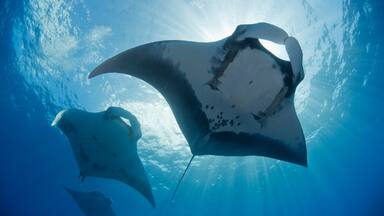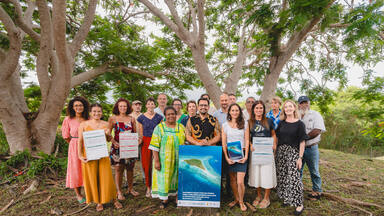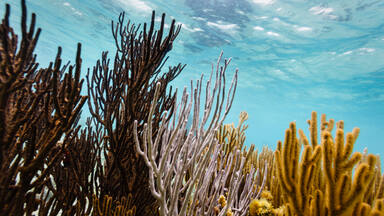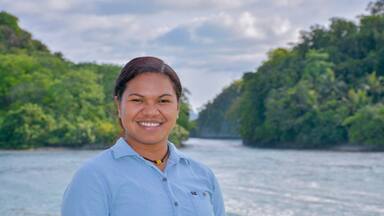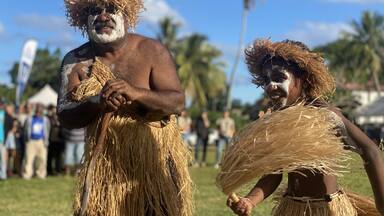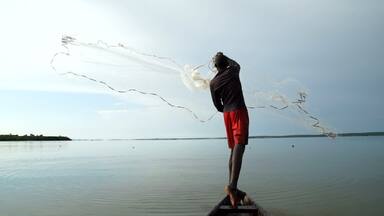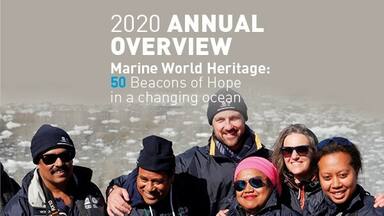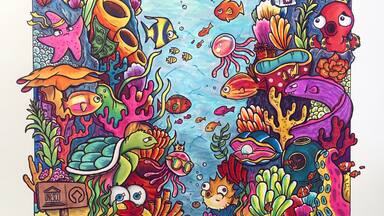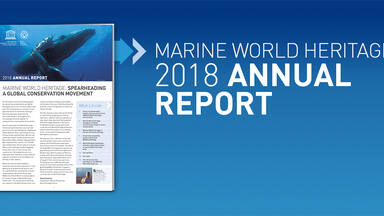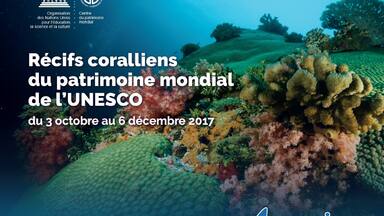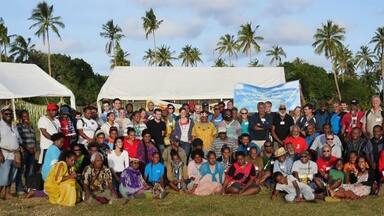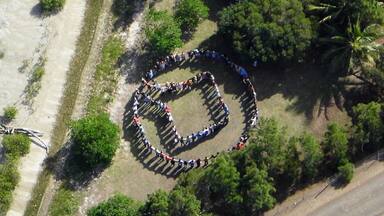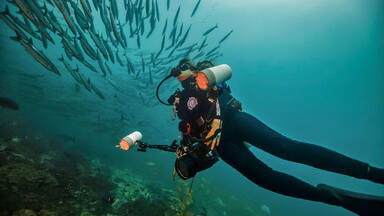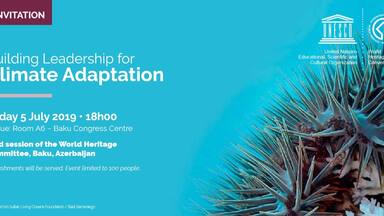Lagoons of New Caledonia: Reef Diversity and Associated Ecosystems
Lagoons of New Caledonia: Reef Diversity and Associated Ecosystems
This serial site comprises six marine clusters that represent the main diversity of coral reefs and associated ecosystems in the French Pacific Ocean archipelago of New Caledonia and one of the three most extensive reef systems in the world. These Lagoons are of exceptional natural beauty. They feature an exceptional diversity of coral and fish species and a continuum of habitats from mangroves to seagrasses with the world’s most diverse concentration of reef structures. The Lagoons of New Caledonia display intact ecosystems, with healthy populations of large predators, and a great number and diversity of big fish. They provide habitat to a number of emblematic or threatened marine species such as turtles, whales or dugongs whose population here is the third largest in the world.
Description is available under license CC-BY-SA IGO 3.0
Lagons de Nouvelle-Calédonie : diversité récifale et écosystèmes associés
Ce bien en série est composé de six zones marines représentant l’ensemble de la diversité des récifs et écosystèmes associés de cet archipel français du Pacifique Sud, un des trois systèmes récifaux les plus vastes du monde. Ces sites sont d’une beauté extraordinaire. On y trouve une diversité exceptionnelle d’espèces de coraux et de poissons, ainsi qu’un continuum d’habitats allant des mangroves aux herbiers et caractérisé par une panoplie de structures récifales parmi les plus diversifiées de la planète. Les lagons et récifs coralliens de Nouvelle-Calédonie abritent des écosystèmes intacts peuplés d'une biodiversité marine exceptionnelle, composée de populations saines de grands prédateurs et d’un nombre considérable de différents poissons de grande taille. Ils offrent un habitat pour plusieurs espèces marines emblématiques ou en danger, comme les tortues, les baleines ou les dugongs, ces derniers constituant la troisième population mondiale.
Description is available under license CC-BY-SA IGO 3.0
بحيرات كاليدونيا الجديدة المرجانية: تنوع الشعَب والنظم الإيكولوجية ذات الصلة
الموقع كناية عن ست مجموعات بحرية تؤوي كل تنوع الشعَب المرجانية والأنظمة الإيكولوجية ذات الصلة في مجموعة جزر كاليدونيا الجديدة الفرنسية، في المحيط الهادي، وتمثل أحد أنظمة الشعَب الثلاثة الأكثر اتساعاً في العالم. يتميز الموقع بتنوعه الاستثنائي (أنواع المرجان والأسماك)، وتواصلية الموائل، من شجر القرم (المانجروف) إلى الأعشاب البحرية، علماً أنه يحوي بنى الشعَب الأكثر تنوعاً في العالم على الإطلاق. تضاهي هذه المواقع، بل وتتجاوز الحاجز المرجاني الكبير في أستراليا من حيث تنوع المرجان والأسماك فيها. تؤوي البحيرات والشعَب المرجانية في كاليدونيا الجديدة نظماً إيكولوجية سليمة لم يطرأ عليها أي تغيير وأنواعاً عديدة ومتنوعة من الحيوانات المفترسة والأسماك الكبرى. كما أنها توفر موئلاً لعدد كبير من الأسماك والسلاحف والثدييات البحرية المهددة، ويُذكر منها ثالث أكثر أنواع الأطوم انتشاراً في العالم (حيوان ثديي مائي يشبه السمك). تتسم هذه المواقع بجمال أخاذ وتشمل شعَباً ذات أعمار متفاوتة، من الشعَب الحية إلى الشعَب القديمة (الأحافير) وتوفر مصدراً هاماً للمعلومات بشأن تاريخ أوقيانوسيا.
source: UNESCO/CPE
Description is available under license CC-BY-SA IGO 3.0
Лагуны Новой Каледонии, разнообразие коралловых рифов и их экосистем
Лагуны Новой Каледонии включают шесть морских кластеров, где сосредоточено все разнообразие коралловых рифов и ассоциированных с ними экосистем Новой Каледонии - французского архипелага в Тихом Океане, – и являются одним из трех наиболее протяженных коралловых рифов мира. Лагуны отличаются исключительным разнообразием видов кораллов и рыб. Их особенностью также является плавный переход от одной среды обитания к другой – от мангровых до водно-растительных зарослей - и концентрация богатейшего в мире разнообразия рифообразующих структур. Лагуны Новой Каледонии – совершенно нетронутые экосистемы, в которых обитают крупные хищники и разнообразные многочисленные крупные рыбы. Они обеспечивают среду обитания для ряда исчезающих видов рыб, черепах, морских млекопитающих, включая третью в мире популяцию дюгоней. Восхищает красота природы этих мест. Здесь находятся рифы разного возраста – от живых до многовековых окаменелых. Объект является ценным источником информации о естественной океанической истории.
source: UNESCO/CPE
Description is available under license CC-BY-SA IGO 3.0
Lagunas de Nueva Caledonia: diversidad de los arrecifes y ecosistemas conexos
Este sitio comprende seis conjuntos marinos representativos de la diversidad principal de los arrecifes coralinos y ecosistemas conexos del archipiélago francés de Nueva Caledonia, situado en el Océano Pacífico, que posee uno de los tres sistemas de arrecifes más vastos del planeta. Las lagunas cuentan con una variedad excepcional de especies de corales y peces, una amplia gama de hábitats que van desde los manglares hasta las praderas marinas, y una de las concentraciones de estructuras de arrecifes más diversificada del planeta. Las lagunas y arrecifes coralinos de Nueva Caledonia albergan ecosistemas intactos con poblaciones numerosas y diversificadas de grandes predadores y peces de gran tamaño. Son el hábitat de múltiples especies de peces, tortugas y mamíferos marinos, entre los que cabe destacar la tercera población de dugongos del mundo por su importancia. El sitio es de una belleza excepcional y alberga arrecifes de diversas edades, vivos y fósiles, que constituyen una fuente de información importante sobre la historia natural de Oceanía.
source: UNESCO/CPE
Description is available under license CC-BY-SA IGO 3.0
ニューカレドニアのラグーン:リーフの多様性とその生態系
source: NFUAJ
Lagunes van Nieuw-Caledonië: diversiteit van riffen en bijbehorende ecosystemen
Source: unesco.nl
Outstanding Universal Value
The tropical lagoons and coral reefs of New Caledonia are an outstanding example of high diversity coral reef ecosystems and form one of the three most extensive reef systems in the world. They are the location for the world’s most diverse concentration of reef structures, with an exceptional diversity of coral and fish species and a continuum of habitats from mangroves to seagrasses and a wide range of reef forms, extending over important oceanic gradients. They still display intact ecosystems, with healthy populations of top predators, and a large number and diversity of large fish. They are of exceptional natural beauty, and contain diverse reefs of varying age from living reefs through to ancient fossil reefs, providing an important source of information on the natural history of Oceania.
Criterion (vii): Superlative natural phenomena or natural beauty: The tropical lagoons and coral reefs of New Caledonia are considered to be some of the most beautiful reef systems in the world due to their wide variety of shapes and forms within a comparatively small area. This ranges from extensive double barrier systems, offshore reefs and coral islands, to the near-shore reticulate reef formations in the west coast zone. The richness and diversity of landscapes and coastal backdrops gives a distinctive aesthetic appeal of exceptional quality. This beauty continues below the surface with dramatic displays of coral diversity, massive coral structures, together with arches, caves and major fissures in the reefs.
Criterion (ix): Ongoing biological and ecological processes: The reef complex within this serial property is globally unique in that it is "free-standing" in the ocean and encircles the island of New Caledonia, providing a variety of different kinds of oceanographic exposure, including both warm and cold currents. The coral reef complex has a great diversity of forms including all the major reef types from fringing reefs to atolls, as well as associated ecosystems in both coastal and oceanic situations. Extending over important oceanic gradients, it is one of the planet's best examples of the ecological and biological processes underlying tropical lagoon and coral reef ecosystems, themselves one of the most ancient and complex ecosystem types.
Criterion (x): Biological diversity and threatened species: The property is a marine site of exceptional diversity with a continuum of habitats from mangroves to seagrasses and a wide range of reef forms. The barrier reefs and atolls in New Caledonia form one of the three most extensive reef systems in the world, and together with the reefs of Fiji, are the most significant coral reefs in Oceania. They are the location for the world’s most diverse concentration of reef structures, 146 types based on a global classification system, and they equal or even surpass the much larger Great Barrier Reef in coral and fish diversity. They provide habitat to a number of threatened fish, turtles, and marine mammals, including the third largest population of dugongs in the world.
Integrity
The serial property comprises six marine clusters which are also protected by marine and terrestrial buffer zones that are not part of the inscribed property. It includes all the key areas that are essential for maintaining its natural beauty and the long term conservation of its remarkable reef diversity, and it is of sufficient size to maintain associated biological and ecological processes. The property still displays intact ecosystems with top predators, and a large number and diversity of large fish.
Protection and management requirements
The property is currently protected by fisheries legislation, which is being further improved, and co-management arrangements with the Kanak communities are currently being established for all clusters. Management plans are currently being prepared for all clusters with full involvement of stakeholders. Continued efforts to protect and manage the property and its surroundings are required to maintain the present intactness of the coral reef ecosystems. Protecting and managing large areas in the form of no-take zones and proactive management of water quality and fisheries regulations will help maintain reef resilience in the face of climate change. Enhanced surveillance and monitoring are required to address potential impacts from fishing and mining and, to a lesser extent, from agriculture and aquaculture. Tourism is likely to increase in the future and needs to be well planned and managed. Sustainable financing strategies are required to ensure the necessary equipment, human and financial resources for the long term management of the property.

